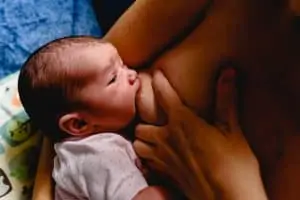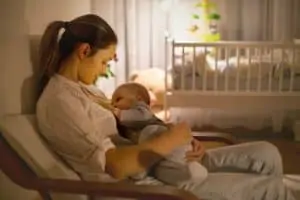While sitting down and nursing is often the most relaxing way to do so, you won’t always be home. Nursing in a ring sling is one way to feed your baby and still have at least one hand free.
As a mom of several kids, learning how to use a ring sling for breastfeeding was one of my favorite tricks. When you have multiple little kids who need you, having open, available hands is a big deal. Someone always needs something, and using a ring sling can keep a hand open. You never know when you need to open a yogurt tube for your preschooler.
Here is why learning how to use a ring sling while nursing is an essential skill – I promise!
Why Nursing in a Ring Sling is Awesome for Moms
You might think that learning a new skill isn’t worth it, but when it comes to this, it is. It’s going to make your life easier, and it also can help improve your breastfeeding relationship with your baby.
If you need a bit of convincing, here are some of the reasons why breastfeeding in a ring sling can be helpful.
- When you’re wearing your baby in a ring sling, you’ll notice hunger cues earlier, so you can feed your baby before he becomes distressed. Since your baby is snuggled close to you, he will start to root around hungrily, looking with an open mouth.
- Being close to your baby helps you learn your baby’s cues and makes the parent more responsive to their baby.
- You can use a ring sling also to practice skin-to-skin care with your babies. We know that kangaroo care increases breastfeeding outcomes and your baby’s weight gain.
- You don’t need both arms when nursing in a ring sling. That means if you’re out and about or busy at home, you can feed your baby while also taking care of your other kids or completing needed chores.
4 Tips for Breastfeeding in a Ring Sling Safely
Learn Each Skill Separately Before Combining
First, I highly suggest that you master breastfeeding and learn how to use a ring sling separately before combining them. If you aren’t comfortable using a ring sling, you won’t be able to breastfeed in it comfortably or confidently, either.
Until Comfortable, Take Your Baby Out
Until you feel that you can confidently and safely combine breastfeeding and babywearing, you should take your baby out of the sling to nurse. You can leave the sling on but loosen it a good deal and use the ring sling tail as a nursing cover if you feel better nursing with a cover.
Don’t Put Your Hand on His Head
You can use your hand to support your baby’s upper back, neck, or even under his butt, but never put your hand on the back of his head. Pressure on your baby’s head makes it hard for them to latch, causing them to lean back away from the breast. So, even though you’re trying to help, it will make it worse for your baby.
Keep an Eye on Your Baby
While feeding your baby, always keep an eye on your baby. You might need to do other things – moms always multi-task – but watch his breathing and coloring. If his oxygen is reduced, you need to watch his coloring and how often he breathes.
How to Breastfeed in a Ring Sling
I suggest that you practice at home in front of a mirror to help figure out the right placements and make sure it looks out from all angles. You have two options for positions: upright or cradle hold.
The upright tends to be a better choice for babies with more head and neck control, but you need to know how to position your baby correctly when using the cradle hold.
Let’s take a look at how to use each position.
Upright Position
Using the upright position is similar to the koala hold or the laid back nursing position. It holds your baby close to your body without gaps, and this position encourages natural breast seeking behavior.

- Sit your baby upright in the ring sling, and loosen the material until your baby is face to face with your breast, with the nipple a little higher than his face.
- Keep your hand on your baby, and reach up to your shoulder, tightening the rail (the side of the ring sling) that will adjust your bottom rail, under your baby’s butt.
- Ensure his hips are spread out in a V shape with the material under his butt and the rail underneath his knees. This position prevents your baby from coming loose, which is often called popping his seat.
- Take out your breast and help your baby latch onto it properly. Then, tighten the top rail to help keep your baby secure. You’ll want to either hold your breast to ensure your baby doesn’t lose it or keep your arm around your baby’s body if you feel worried that he might fall.
Cradle Hold Position
If you want to use your ring sling breastfeeding for a newborn baby, the cradle hold, or reverse cradle hold, can be a great position. The ring sling forms against your baby, keeping him close to your body after you tighten the rings. It molds to your baby, providing all of the support you need.
However, you need to make sure your baby’s chin is NOT tucked in, making nursing and breathing difficult. His head needs to either be forward, in the normal position, or slightly tilted upward.
Here’s what you need to do.
- Put your ring sling on without your baby, keeping it loose, and put your baby into the sling with his head facing the side toward the breast you want to nurse.
- Tuck the material under your baby’s side, putting it between you and the baby, creating a pocket for your baby. Tighten your bottom rail at the rings to help secure your baby.
- Take out your breast and help your baby latch on it, finding a comfortable position for both of you while ensuring his chin is NOT tucked.
- Tighten the top rail slightly, and you can use the ring sling tail as a cover over your breast while your baby nurses.
You also can use this position to bottle feed in a ring sling. Face your baby upwards more rather than facing your breast, and keep your arm under your baby to support your child.
Final Thoughts
Nursing in a ring sling is such an easy skill to learn, and it can help make nursing on the go a lot easier. You can use this skill to nurse while out at the store or washing the dishes at home. Trust me; you’ll find ways to breastfeed in your ring sling!
Hey, this is Linda. My biggest accomplishment in life is being a mother of four children. Their current ages range from almost ten years old down to 20 months old.
I’m passionate about writing parenting articles because I understand so well all of the problems and trials you face as a parent. From breastfeeding woes to budgeting problems and behavior problems, along with everything in between, chances are I’ve faced it over the last ten years. Read more about Linda here.






